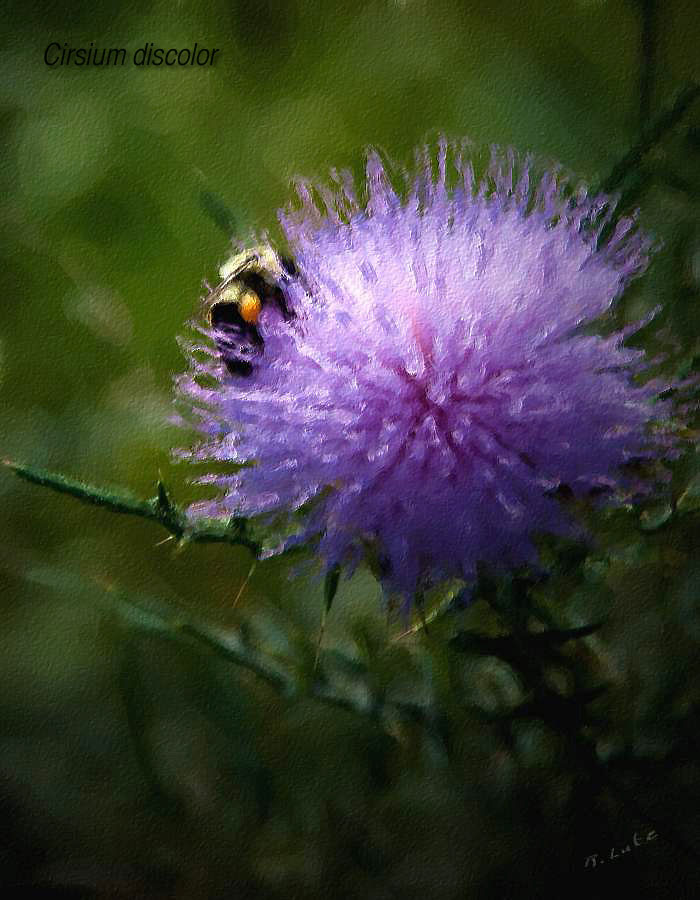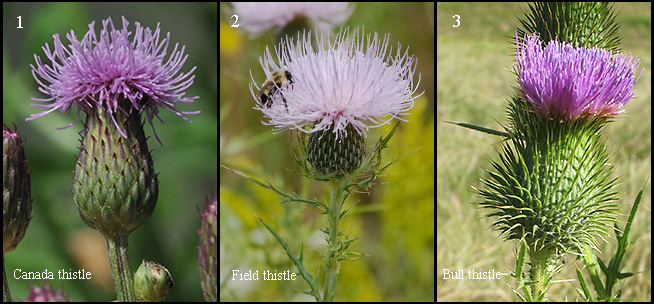Cirsium ssp. (thistles)

Cirsium
The attributes of the genus Cirsium (plume thistles) are available at these links: FNA, USDA, Wikipedia. Distribution information is available from BONAP and The Vascular Plants of Iowa.
[Note: plume refers to the pappus structure in this group. Sometimes called thistle down, the pappus is attached to the cypsela (an achene containing a single seed) and, like a parachute, floats it on air currents. Under close inspection, individual strands, like feathers (plumes), have secondary bristles on both sides of the main axes. (photo)]
The Cirsium species you are most likely to encounter in Iowa are:
Cirsium altissimum [native] (Tall thistle) [synonym? C. iowense see discussion.]
Cirsium arvense [Alien] (Canada thistle)
Cirsium discolor [native] (Field thistle)
Cirsium flodmanii [native] (Flodman's thistle)
Cirsium hillii [native] (Hill's thistle) [syn. C. pumilum]
Cirsium muticum [native] (Swamp thistle)
Cirsium undulatum [native] (Wavyleaf thistle)
Cirsium vulgare [Alien] (Bull thistle)
Comparing the floral heads of the three most prominent thistles in our area should help with identification:

The relative sizes of the thistle heads can be of some help, #1 the canadian thistle (Cirsium arvense) has heads between 1 and 2cm tall. #2 the field thistle (Cirsium discolor) is about twice as large and #3 the bull thistle (Cirsium vulgare) is two to three times as large. The field thistle (#2) has a very visible white glutenous ridge on the outer (abaxial) side of its phyllaries—these become less visible as they darken with age. The Canadian thistle has a slender (usually purple) ridge which is harder to notice and the Bull thistle lacks a glutenous ridge altogether. Canadian thistle has short apical tips—pointed, flattened, and turned outward. The field thistle, #2 has thin out-turned needle-like phyllary tips (not very apparent in the photo above). The bull thistle (#3) has phyllaries with curving spines—curving more at the base of the involucre.
Thistles
Thistles are characteristically spiny and difficult to work around. Their spines are an excellant defense against browsing herbivores. But the prickly features that have evolved to protect them from other species are the reasons that people want to destroy them. Some species are invasive, and for this and
other reasons state legislatures have made them outlaws. The
Iowa weed law, for example, designates all of the members of two genera (
Cirsium and Carduus) as
"primary noxious weeds". However, it should be said in their defense that Iowa's pollinating insects and several of its bird species, including Iowa's state bird
(The American Goldfinch), find these plants very much to their liking.
At least
fifteen genera have spiny representatives with "thistle" in their common name.
Seven of these have been found in Iowa:
Carduus (plumeless thistle),
Carthamus (Distaff thistle),
Centaurea (Star thistle),
Cirsium (Plume thistle),
Echinops (Globe thistle),
Onopordum (Cotton or Scots thistle),
Sonchus (Sow thistle).
Representatives of these
seven genera are mostly non-native and absent or infrequent in Iowa. However, there are three exceptions. These are
Carduus,
Cirsium and
Sonchus.
Carduus contains
two species in Iowa (
C. nutans and C. acanthoides); both are alien, invasive, and are usually found in Iowa's western counties.
Cirsium has
eight species in Iowa. Four of these are widely distributed and invasive. These four are sometimes referred to collectively as Iowa's field thistles. Two of these are alien—
C. arvense (Canada thistle) and
C. vulgare (Bull thistle) and two are native—
C. altissimum (Tall thistle) and
C. discolor (Field thistle). One species,
C. flodmanii (Flodman's thistle), is found in the west (primarily the N.W.) part of the state. The remaining three species are neither frequent nor invasive and may even deserve a protected status in Iowa. These are:
C. hillii (Hill's thistle),
C. muticum (Swamp thistle), and
C. undulatum (Wavyleaf thistle). There are three species of
Sonchus in Iowa; these are
S. arvensis (field sowthistle),
S. asper (spiny sowthistle), and
S. oleraceus (common sowthistle). The first (
S. arvensis) is classified as a
Primary noxious weed in Iowa.
The USDA plant site shows
95 species (in the U.S.) for the Genus
Cirsium—10 species are shown in Iowa. Two of these,
C. canescens and C. X iowense (altissimum x discolor), are absent from other Iowa lists. Nine of the ten Iowa species are usually described as biennials. One, (Canada thistle) as perennial.
The two alien
Cirsium species (Canada thistle and Bull thistle) are thought to have Eurasian origins, probably from regions around the Mediterranean. This would mean that the Canada thistle is misnamed since it is not native to Canada. There are several online sources that aid in the identification and control of these two aggressive thistles. Here are three:
1,
2,
3.
A statement from David Keil's description of Cirsium is worth quoting here:
The reputation of Cirsium has suffered greatly as a result of the introduction to North America of a few invasive weedy
species from Eurasia. Cirsium vulgare (bull thistle) and C. arvense (Canada thistle—a misnomer) have long been
despised as noxious weeds. In recent years C. palustre (European swamp thistle) has joined their ranks. Additionally,
weedy Eurasian species of Carduus, Onopordum, Centaurea, etc., add to the public perception that all thistles are
bad. Most North American native Cirsium are not at all weedy, and many are strikingly attractive plants. All are spiny
plants that command respect, but they deserve a better reputation as one of North America's evolutionary success stories.

